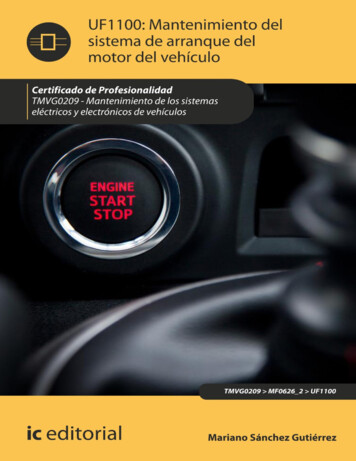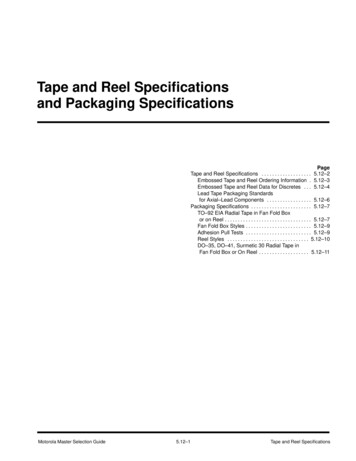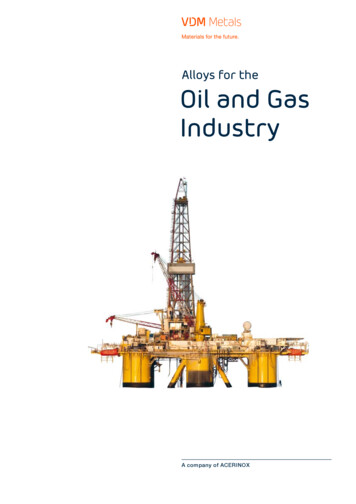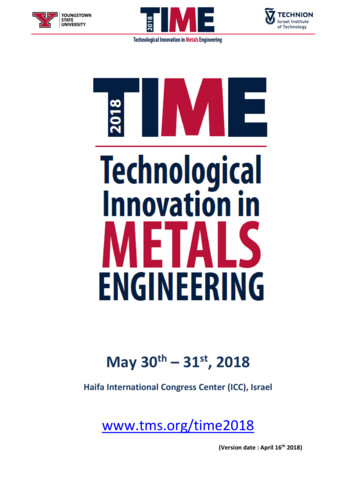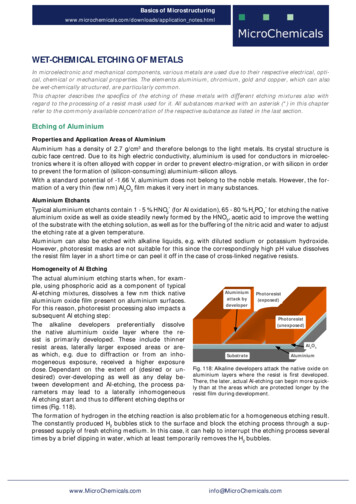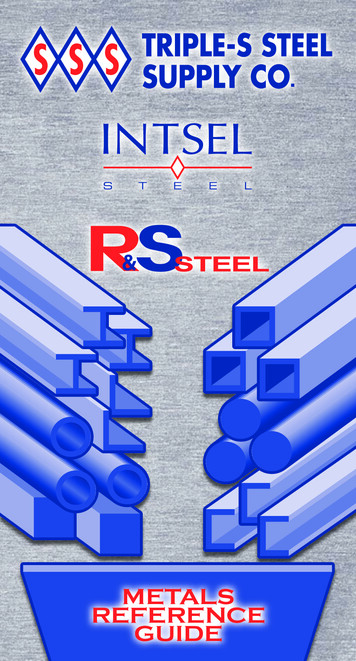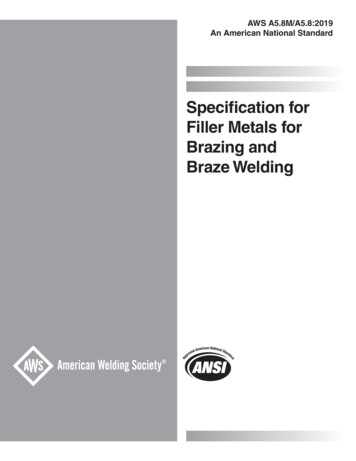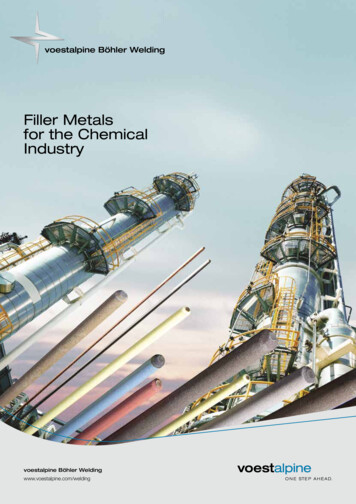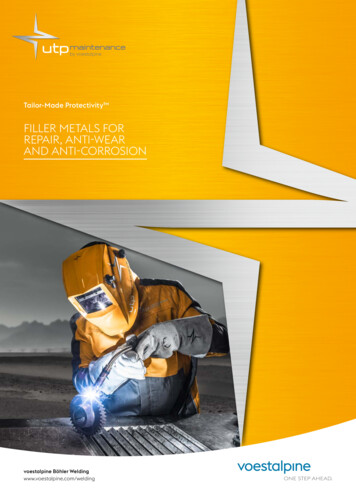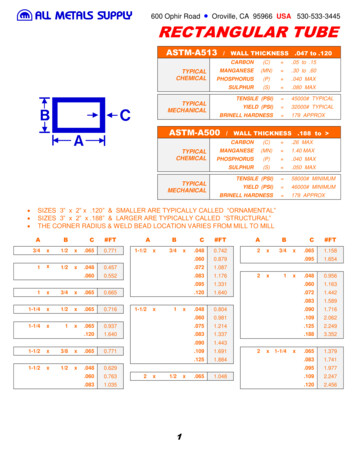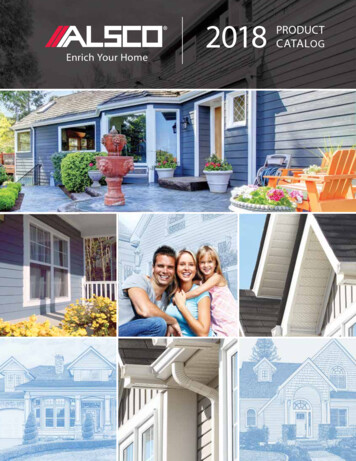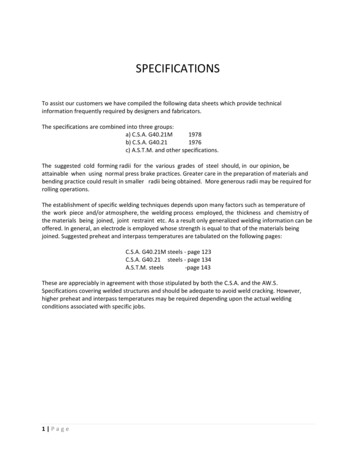
Transcription
SPECIFICATIONSTo assist our customers we have compiled the following data sheets which provide technicalinformation frequently required by designers and fabricators.The specifications are combined into three groups:a) C.S.A. G40.21M1978b) C.S.A. G40.211976c) A.S.T.M. and other specifications.The suggested cold forming radii for the various grades of steel should, in our opinion, beattainable when using normal press brake practices. Greater care in the preparation of materials andbending practice could result in smaller radii being obtained. More generous radii may be required forrolling operations.The establishment of specific welding techniques depends upon many factors such as temperature ofthe work piece and/or atmosphere, the welding process employed, the thickness and chemistry ofthe materials being joined, joint restraint etc. As a result only generalized welding information can beoffered. In general, an electrode is employed whose strength is equal to that of the materials beingjoined. Suggested preheat and interpass temperatures are tabulated on the following pages:C.S.A. G40.21M steels - page 123C.S.A. G40.21 steels - page 134A.S.T.M. steels-page 143These are appreciably in agreement with those stipulated by both the C.S.A. and the AW.S.Specifications covering welded structures and should be adequate to avoid weld cracking. However,higher preheat and interpass temperatures may be required depending upon the actual weldingconditions associated with specific jobs.1 Page
Guide to Structural Steel SelectionCSA G40.21MStructuralQuality SteelCSA G40.21Designation ofSimilar Steel1Maximum ThicknessASTM Designation ofSimilar Steel1Max. ShapeGroupPlate or Barmm5HSS Wallins.mmins.12--230G33GA36; A283 Gr. D350G50GA4403301 1/4--400G60G-3301 1/4--A364401 1/2--1 1/2165/81 1/2165/8-165/8260W38W300W42W*, 44W350W50WA572 Gr. 42 Gr. 453003 & HSSA572 Gr.502 & HSS4040380W*55W*A572 Gr.55HSS400W60WA572 Gr.601203/4--480W70WA572 38TA36 KFG300T44TA572 Gr.45 KFG350T50TA441 K; A572 Gr.50KFG380T*55T*A572 Gr.55 KFG400T60TA572 Gr.60 KFG480T70TA572 Gr.70 KFG350R50RA2421141/2--165/851004 & HSSHSS211002020350A50AA242A; A5885 & HSS1004400A60A-2401 1/2--480A70A--203/4--A514-502--700Q100Q*These grades are available in hollow structural sections only.(1) Similarity in yield strength, description and application; not necessarily in chemical composition ortest requirements; see the individual specifications for details.(2) Assumes suitable welding technique is used.(3) Refers to steel without paint or other protective coating.(4) Atmospheric corrosion resistance can be enhanced to FAIR by specifying copper additions.2 Page
Weldability2Low Temp.ToughnessAtmospheric CorrosionResistance3G to VGVGVG-GVGVGVG-GVGVGG withpropertechnique--3 anesesteels, SemiKilledBolted structuresWeldablecarbonmanganesesteels, SemiKilledGeneral useweldedconstructionWelded carbonmanganesesteels, Killed FineGrain (KFG)practice, for lowtemperatureserviceWelded bridgesLow-alloycorrosionresisting steel,KilledExposedunpaintedcladding and lightstructuralmembersLow-alloycorrosionresisting steel,KFG for lowtemperatureserviceLow-alloy, KFG,Quenched andTempered highstrength steelExposedunpaintedbridgesBridges andspecialapplications
Shape Size GroupingsFor Tensile Property ClassificationShapeWide Flange Shapes(Nominal depth in mmby Mass in Kg./m)(W Shapes)Light MiscellaneousBeams and Columns(M Shapes)Standard I Beams(S Shapes)H Bearing Piles(HP Shapes)Standard Channels(C Shapes)Miscellaneous Car &Shipbuilding Channels(MC Shapes)Angles, Bulb Angles,Group 1W610 x 82,92W530 x 66to 85 incl.W460 x 52to 106 incl.W410 x 39to 85 incl.W360 x 33to 79 incl.W310 x 21to 86 incl.W250 x 18to 67 incl.W200 x 15to 71 incl.W150 x 13to 37 incl.W130 x 24,28W100 x 19Group 2W920 x 201to 313 incl.W840 x 176to 226 incl.W760 x 147to 314 incl.W690 x 125to 265 incl.W610 x 101to 241 incl.W530 x 92to 219 incl.W460 x 113to 177 incl.W410 x 100to 149 incl.W360 x 91to 196 incl.W310 x 97to 158 incl.W250 x 73to 167 incl.W200 x 8610Group 3W920 x 342to 446 incl.W840 x 299to 359 incl.W360 x 216to 314 incl.W310 x 179to 283 incl.Group 4W360 x 347to 818 incl.W310 x 313to 500 incl.to 56 Kg/mto 52 Kg/mOver 52Kg/mto 152 Kg/mto 30.8Kg/mOver 30.8Kg/mto 42.4Kg/mOver 42.4Kg/mOver 152Kg/mOver 13 mmOver 20 mmto 20 mmthk.Zees and Rolled Teesthk.(1) Shape size grouping of rolled shapes is in accordance with CSA G40-20-M19784 Pageto 13 mmthk.Group 5W360 x 900to 1086 incl.
CSA G40.21M-1978 and G40.21 (1976)Structural Quality SteelsThis Standard includes materials having a number of different types, defined as follows:Type G - General Construction Steel. Steels of this type meet minimum strength requirements;however, the chemical control is not such that all of these steels may be welded satisfactorily undernormal field conditions. They are primarily designed for applications involving bolted connections or forwelding under carefully controlled shop conditions;Type W - Weldable Steels. Steels of this type meet minimum strength requirements and are suitable forgeneral welded construction where notch toughness at low temperatures is not a prime consideration.Applications may include buildings, compression members of bridges, etc.Type T - Weldable Steels. Steels of this type are suitable for welded construction and may be specifiedwhen low-temperature notch toughness is a prime consideration in design. In such cases Charpy V-notchtesting should be specified by the purchaser to ensure that the impact requirements are met.Type R - Atmospheric Corrosion-Resistant Structural Steel. Steels of this type display an atmosphericcorrosion resistance approximately four times that of plain carbon steels.* These steels may bereadily welded up to the maximum thickness covered by this Standard. Applications includeunpainted siding, unpainted light structural members, etc., where notch toughness at low temperaturesis not a consideration.Type A - Atmospheric Corrosion-Resistant Weldable Structural Steel. Steels of this type display anatmospheric corrosion resistance of approximately four times that of plain carbon steels.* These steelsmay be welded readily under normal conditions and are often used in structures in the unpaintedcondition. These steels may be specified when low-temperature notch toughness is a primeconsideration in design. In such cases, Charpy V-notch testing should be specified by the purchaser toensure that the impact requirements are met.*Copper content not exceeding 0.02 per cent.Type Q - Quenched and Tempered Low Alloy Steel Plate. Steels of this type display a very high yieldstrength and good resistance to brittle fracture and are especially suited for bridges and similarstructures. While these steels may be readily welded, the welding and fabrication techniques are offundamental importance and must not adversely affect the properties of the plate, especially the heataffected zone.A number of strength levels are available under this Standard, and are designated by theapproximate yield strength which is incorporated in the C.S.A. Grade Number, similar to thefollowing examples:Metric G40.21M-1978 - Grade 230G - (Yield Strength 230 MPa- Type G).Imperial G40.21 (1976) - Grade 33G- (Yield Strength 33 Ksi- Type G).The grades, types, and strength levels normally available are shown on the following pages.5 Page
CSA G40.21M-1978FormabilityOLD FORMINGPlates and bars of all CSA G40.21M grades can be satisfactorily formed on a press brake or otherconventional cold bending equipment There is a considerable difference in the formability of thedifferent grades due to the strength level and chemical composition differences; because of this, caremust be exercised when forming is required.The following table summarizes the results of research and experience and is offered as a guide to theminimum bend radius that can be expected for different grades and thicknesses. These criteria applystrictly to longitudinal bends, i.e., where the bend line is transverse to the rolling direction. Transversebends may require up to twice the indicated radius. It is assumed that the bend is not carried out on anedge that has been flame-hardened by gas cutting, on heavily burred or work hardened by shearingunless some special edge preparation, such as grinding or chipping has been carried out.SUGGESTED MINIMUM BEND RADIUS: Longitudinal BendsGradeUp to 80T350R350A400A480A1t2 1/2t3t1 1/2t1 1/2t2 1/2t3 1/2t5t1 1/2t1 1/2t2 1/2t3 1/2t4t2t2t3t4tOver 6 to 12Over 12 to 251t2t3 1/2t5t1 1/2t2t2t3t2 1/2t4t3 1/2t6t5t2t3t2t3t3t4t3 1/2t6t5t6t3t3t5t4t6t5t6tT thickness in mmOver 25 to 40Over 40 to 503t3t4t4t4t-4t4t5t-HOT FORMING - is recommended for all thicknesses not showing a value. Since temperature can be a majorcause of bend failure, in no case should bending be carried out at a metal temperature below 15 C.Material of 350 MPa and higher yield strength will require greater bending and hold down force than lowerstrength steels and provisions must be made for a greater than usual degree of spring back.The cold bending of structural shapes is a most difficult task and the steel producer should be consulted beforecold bending of any degree of severity is carried out.6 Page
CSA G40.21M-1978WeldingAll grades of CSA G40.21M steels can be readily welded with the exception of Grades350G and 400G which can be welded under carefully controlled conditions. It is urged that therequirements of CSA Standard W59-1977 "Welded Steel Construction (Metal Arc Welding)" be followedas a minimum.The suggestions set forth in this guide are intended to meet these requirements. However, theapplicable standard or code should be consulted before establishing any procedures.SUGGESTED FILLER MATERIALS:Manual ElectrodesSubmergedGas Metal ArcFlux-Cored Metal ArcGrade(SMAW) CSA W48.1,Arc (SAW) CSA(GMAW) CSA(FCAW) CSA W48.548.3W48.6W48.4230GE6010, 11, 13, 20, 27F6Z-ELXXE70-X, E70U-XE60T-8, E70T-X260W, 260TE7015, 16, 18, 28, 38F70-EMXXE70-X, E70U-IE60T-8, E70T-X(a)300W, 300TE7015, 16, 18, 28, 38F70-EMXXE70-X, E70U-IE70T-X (a)350G, 350W350R, 350AE8015-B4L61 (b)E70T-G2400AE8016-B2, C1-3XXX10 FluxE8018-82, C1-3400G, 400WW8015, 16, 18F80-EMXXE80SE80T400T480W, 480TE8015, 16, 18F90-EMXXE90E90T480AE9018M(b)(b)(b)(a) Exclusive of E70T-2, E70T-3, E70T-G.(b) Consult consumable manufacturer.EXPOSED STEEL:When steels of Types Rand A are used in the exposed, bare, unpainted condition, the electrodes suggested orothers producing a similar alloy composition in the deposited metal should be used, For applications where thematerial is not boldly exposed, where colour match is not important, for all but capping passes in multipasswelds and for narrow single pass welds, the electrodes suggested for Grades 300T, 400T and 480T may be used.SUGGESTED MINIMUM PREHEAT AND INTERPASS TEMPERATURES:Welding should not be carried out when the ambient temperature is below -20 C. When the base metaltemperature is below the temperature listed for the welding process and thickness it should be preheated insuch a manner that the surface of the material on which the weld is to be deposited is at or above the suggestedminimum temperature for a distance equal to the thickness of the material but not less than 75 mm bothlaterally and in advance of the welding. When the base metal temperature is below 0 C, it should be brought up toand maintained at 10 C during welding, for all grades. Temperatures higher than the minimum suggested may berequired for highly restrained welds.Thickness of theThickness PartatPoint of WeldingShielded Metal Arc (other thanBasic Electrodes)Flux-Cored Arc Welding230G, 300W, 300TUp to 20 mmOver 20 to 38 mmOver 38 to 63 mmOver 63 mm7 Pagenone65 C110 C150 CShielded Metal Arc with Basic Electrodes,Submerged Arc Welding, Gas Metal Arc Welding,Flux-Cored Arc Welding260W 260T 350R350G 400W 400T300W 300T 350A400G 480W 480T350W 350T 400A480Anone10 C10 C65 C65 C110 C110 C150 C
CSA G40.21M-1978 and G40.21 (1976)Type G – General Construction SteelDISCUSSIONType G steels are basically carbon-manganese steels, usually produced to a semi killed steel-makingpractice and have minimum controls placed upon the chemical composition. The steels are designedto provide the required strength levels with the lowest possible cost of materials. Steels of this typehave found considerable usage in bolted structures, such as transmission towers, microwave towers,material handling equipment etc. They are not recommended for low temperature service. However,where the fabrication methods do not create notch effects and only limited thick nesses are used,satisfactory low temperature service has resulted. These steels are often welded under shopconditions where preheat and other temperatures can be carefully controlled but are notrecommended for field welding where adequate control may be difficult or impossible to maintain.AVAILABILITYGrade 230G is readily available in plate thicknesses up to 100 mm. It is not normally produced instructural shapes. Grades 350G and 400G are not available in plate and are usually available only in theform of angles. Since these grades are not regularly rolled, the producer should be contacted prior toany commitment to their use.CORROSION RESISTANCEThese steels have the same atmospheric corrosion resistance as plain carbon steels; however, this maybe enhanced somewhat by specifying a minimum copper addition.NOTCH TOUGHNESSSteels of this type are not recommended for any application requiring notch toughness in the material.WELDABILITYWhile Grade 230G can be readily welded, it is recommended that Grades 350G and 400G not be usedfor structures involving welding in the fabrication except under very carefully controlled conditions. Forsuggestions of procedures to be used
ASTM Designation of Similar Steel1 Max. Shape Group Maximum Thickness Plate or Bar HSS Wall mm ins. mm ins. 230G 33G A36; A283 Gr. D 5 300 12 - - 350G 50G A440 3 30 1 1/4 - - 400G 60G - 3 30 1 1/4 - - 260W 38W A36 4 40 1 1/2 - - 300W 42W*, 44W A572 Gr. 42 Gr. 45 3 & HSS 40 1 1/2 16 5/8 350W 50W A572 Gr.50 2 & HSS 40 1 1/2 16 5/8 380W* 55W* A572 Gr.55 HSS - - 16 5/8 400W 60W A572
